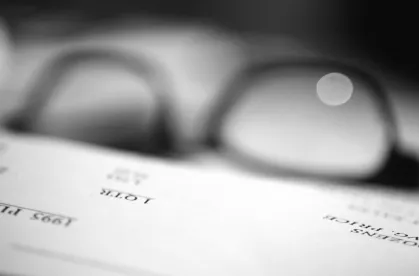Declaratory judgment actions can be a useful way for entities threatened with patent infringement to go on the offensive. In one such matter in the District of Massachusetts, a declaratory judgment plaintiff turned the tables on a patentee by invalidating two patents relating to eyeglass screw technology at the summary judgment stage.
The patents-in-suit were directed to a screw with an elongated tapered end connected to the threaded portion of the screw by a narrow section, such that the tapered end would protrude through the bottom of the screw hole and could then be snapped off. The tapered end assisted with alignment and positioning of the screw. Plaintiff Hilsinger Company (“Hilco”) brought its declaratory judgment action against Eyeego in 2013, asserting that Eyeego’s patents were invalid in view of the prior art and not infringed. Eyeego brought counterclaims against Hilco, contending that its patents were valid and that Hilco’s screw design infringed them. After a period of discovery, the parties filed competing summary judgment motions on these issues.
The court first focused on the issue of whether Eyeego had standing to pursue its infringement claims, in view of two licensing transactions involving Eyeego’s patents. In 2012, Eyeego entered into an exclusive license agreement with OptiSource International for manufacturing and distribution of the patented screw. Notably, Eyeego retained its right and obligation to bring suit against Hilco and OptiSource could not assert any infringement actions without Eyeego’s written consent. In 2013, after filing of the present litigation, Eyeego assigned its rights to SnapIt Screw, which in turn transferred the rights to FBB Asset Management. Later in 2016, FBB transferred the rights back to Eyeego.
Based on the above set of facts, Judge Talwani ruled that Eyeego did have standing because Eyeego never relinquished its right to enforce the patents to OptiSource and at relevant times in the litigation—at the complaint/answer stage and the summary judgment stage—Eyeego owned the patents.
Next, the court turned its attention to resolving the parties’ competing motions on the issue of validity. Hilco relied on two trade catalogs, Sadler Screw and CentroStyle Screw, depicting similar screw designs as the main pieces of prior art in support of its invalidity assertions. In order for the catalogs to qualify as printed publications, Hilco had to show that they were disseminated to the public before the relevant priority date of August 6, 2007. For the Sadler Screw catalog, Hilco offered testimony from its Vice President of Engineering Thomas Sadler—who was formerly the president of the Sadler company—that the catalog was distributed to optical professionals prior to 2007. For the CentroStyle Screw catalog, Hilco introduced testimony from another Hilco employee who stated that she collected and maintained currently-available trade catalogs—including the CentroStyle catalog—during the relevant time period. Judge Talwani concluded that the testimony supported a finding that the catalogs were disseminated to the public, and therefore that Hilco had met its burden on this point with respect to both catalogs.
Regarding the issue of whether the cited prior art catalogs anticipated or rendered obvious Eyeego’s patents, one of the disputes involved a key claim element (an element that was present in both patents):
“wherein the breakaway has a diameter sized so that the non-threaded second portion is directly decoupled from the threaded first portion of the elongated stem at the breakaway by hand, without the use of a tool” (emphasis added).
Because the Sadler Screw catalog provided no direct indication that users should snap off the bottom portion of the screw, Hilco again relied on testimony from Thomas Sadler who declared that he would routinely snap off the elongated portion of the Sadler screws by hand during demonstrations at trade shows. Sadler’s testimony was supported by Hilco’s expert, who testified that he saw Sadler perform this demonstration.
To counter this, Eyeego sought to introduce a declaration from the file history of one of its patents, in which the declarant Jim Heil rebutted the notion that the Sadler screw was breakable by hand. Judge Talwani concluded that Heil’s statement amounted to expert testimony and Eyeego had failed to disclose Heil as an expert on its required disclosures. As a result, Heil could not be a witness at trial. Because Eyeego was offering Heil’s statements for the truth of the matter asserted therein and Heil could not testify at trial, Judge Talwani struck the declaration as inadmissible hearsay—and Eyeego had no other evidence regarding the breakability of the Sadler screw.
The facts surrounding the CentroStyle Screw catalog were more straightforward. There, the catalog expressly instructed users to “[s]nap-off” (not cut-off or clip-off) the non-threaded portion. In addition, the catalog included a drawing that depicted a person’s thumb and index finger grasping the elongated portion prior to snapping it off.
Eyeego attempted to counter this evidence by introducing declarations of two individuals who claimed that during a February 2016 trade show, a CentroStyle representative told them that the drawing noted above depicted a set of pliers, not fingers. Again, the Court struck these declarations as inadmissible hearsay because involve statements of an out-of-court witness to prove the truth of the matter asserted in the statements. Eyeego offered no other evidence to support its contention that the catalog depicted pliers.
In light of the above, Judge Talwani determined that “[t]here are therefore no disputed facts that prevent Hilco from showing by clear and convincing evidence that the prior art teach the breakability by hand limitation.” The Court subsequently granted Hilco’s motion for summary judgment of invalidity of the relevant claims of Eyeego’s patents that included this breakability by hand limitation.
The Court’s opinion in this matter highlights an important, but sometimes overlooked, aspect of relying on testimony to support claims and contentions during litigation. Parties should ensure as early as possible that such testimony is properly admissible and is not subject to defects like those that befell the defendant here.
The case is The Hilsinger Company v. Eyeego, LLC, Civil Action No. 1:13-cv-10594-IT (D. Mass. September 26, 2016), before Judge Indira Talwani.



 />i
/>i

